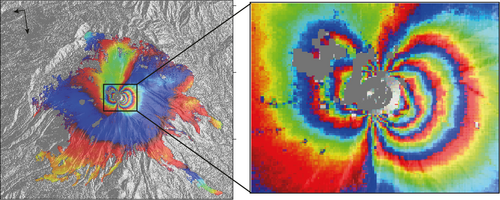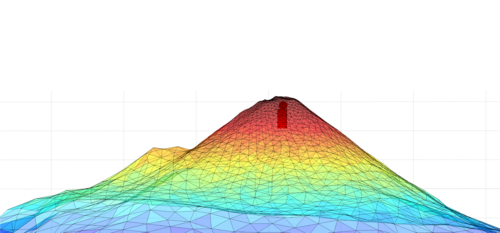Methods
Imaging methods have been applied for decades to study volcanic processes. The VolCapse project will build upon the experience gained from volcano observatories and from historic episodes of growing volcanoes and employ systematic imaging methods. Here we exploit satellite based and ground based imaging methods, which by combination allow observation of displacements from safe distance and at unprecedented temporal and spatial resolution.
Satellite data: Modern satellites, such as TerraSAR-X and Sentinel-1 sample every 6-11 days. For displacement detection we retrieve information from both pixel offsets (PO) and phase interferometry (InSAR), following a rationale similar to the Small BAseline Subset (SBAS) differential SAR interferometry approach. The amplitudes of the selected image pairs are to be used in order to calculate the relative across-track (range) and along-track (azimuth) pixel-offsets.
Figure: Satellite InSAR data and pixel offset calculations at dome building volcanoes allow detailed deformation monitoring.
IP camera arrays. Let us assume we have a camera mounted on a stable position from where the dome is photographed. In the simplest case, one can estimate the shift between images by computing the perturbation of an image as a shifted copy of the reference image. For an image data set consisting of several thousands of images as a function of time, the image intensity function allows exploration of the displacement at a given time increment. Subdividing an image into smaller subregions now also allows detection of the shift in very localized volcano parts only (Walter, 2011). To be able to monitor volcano dome deformations, we install fixed time lapse, remotely operatable cameras at distance from the volcano. A configuration chosen to allow three dimensional vector computations.
Figure:Digital image correlation from time lapse photography data is highly flexible in terms of resolution in time and space, providing displacements in three dimensions if well chosen camera positions are combined
Modelling: Displacements are further analysed in models. Mathematical models are developed to simulate deformation sources. By fitting the time-lapse surface observations to the predictions from those idealized models, the VolCapse team is able to quantitatively estimate the source location, geometry and dynamics. What is the nature of the inflating, deflating, and growing bodies, their shape, size and location underneath the volcano edifice? Consideration of complex sources with an enclosed volume, so-called finite source geometries, is realised using boundary element methodology.
Herewith we explore the influence of different types of stress changes, such as the normal stress acting on the dome margin and conduit.
Figure: Model simulations allow to identify the source of deformation, and determine the stress field changes in the volcano.





